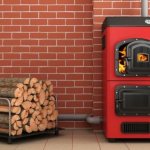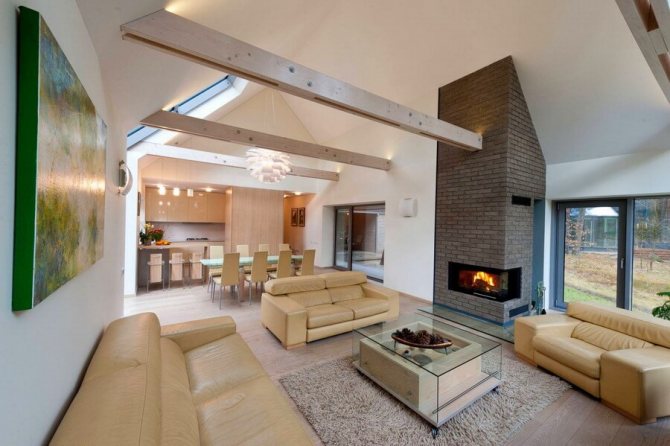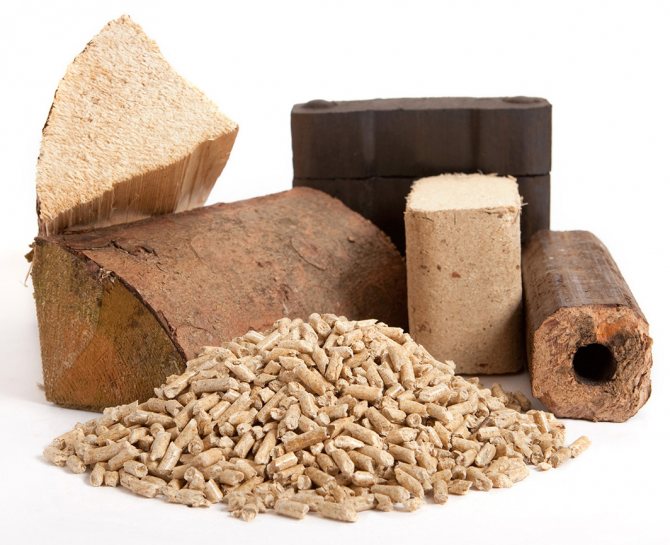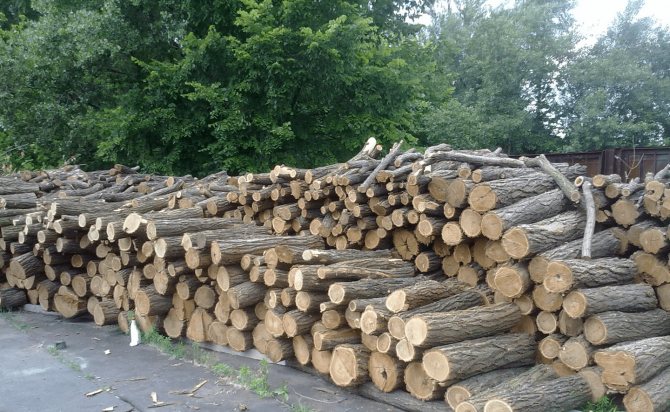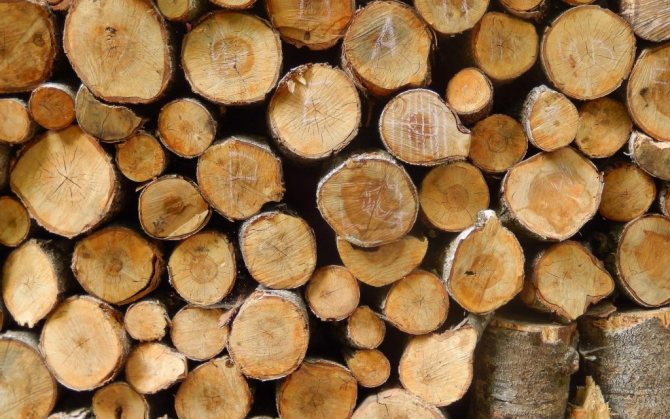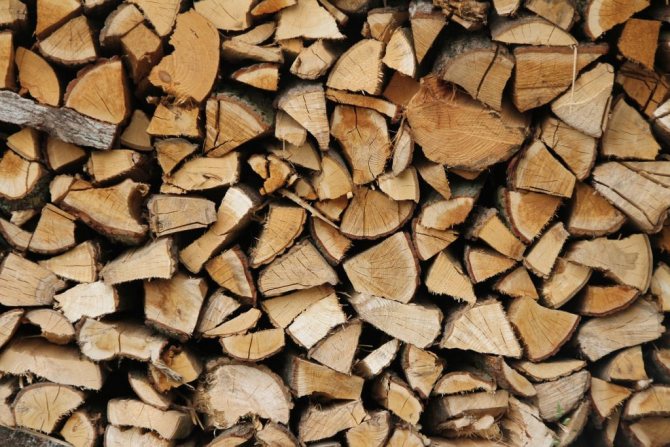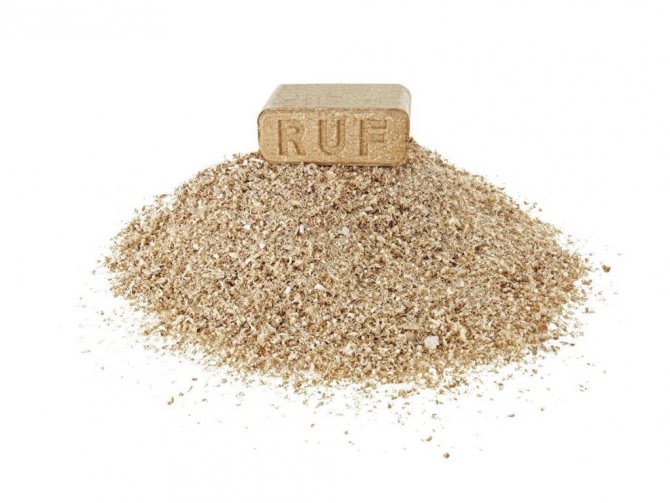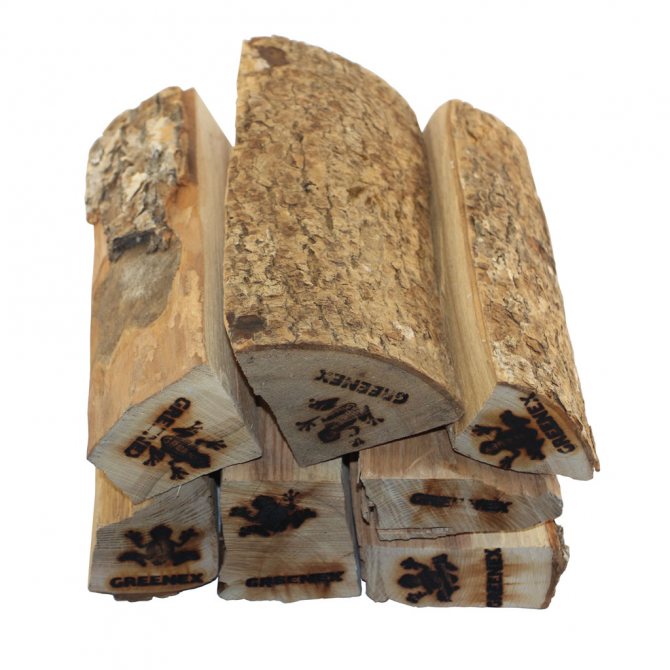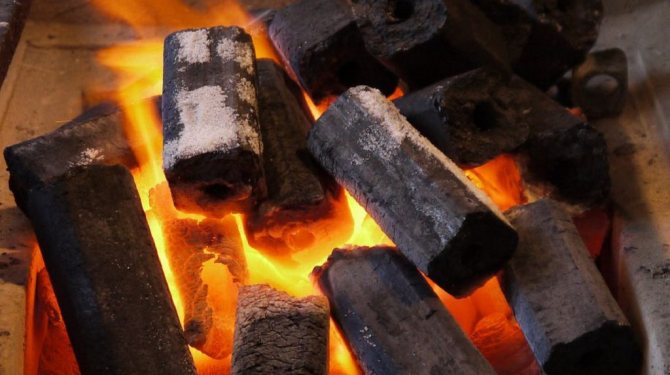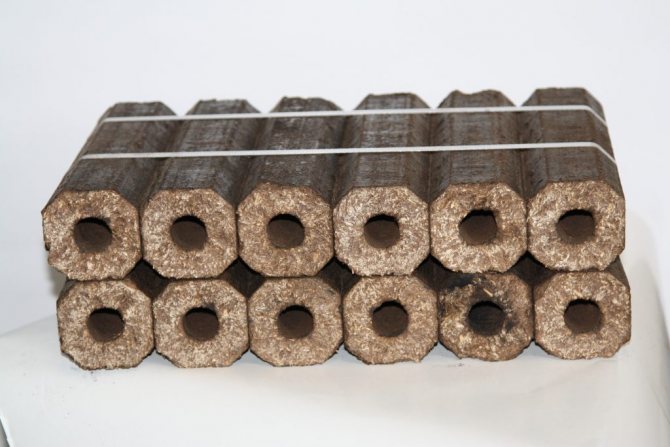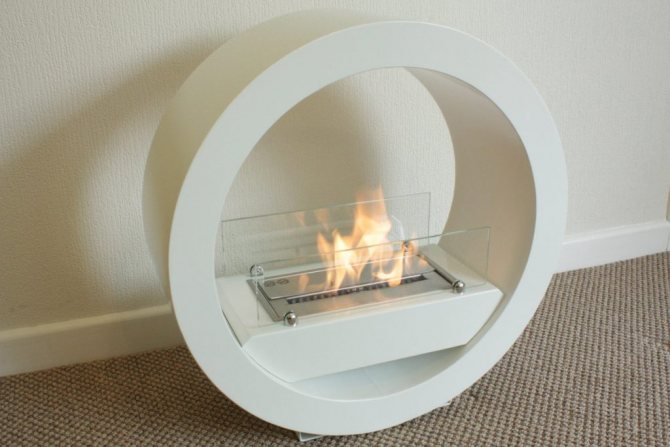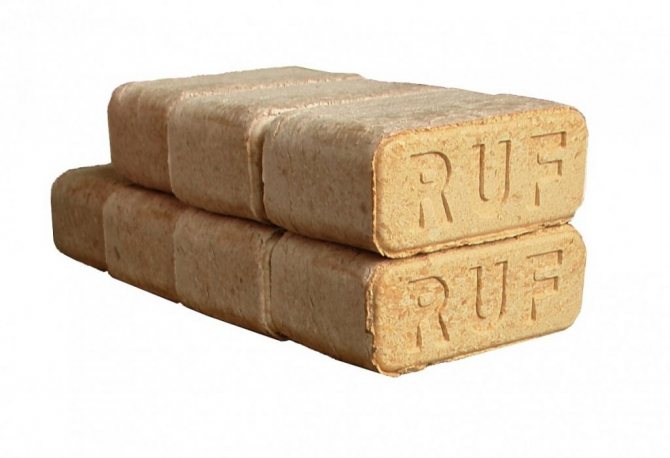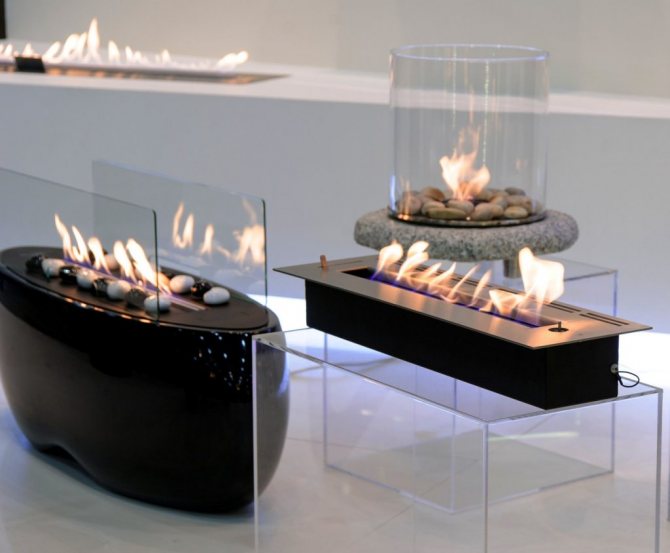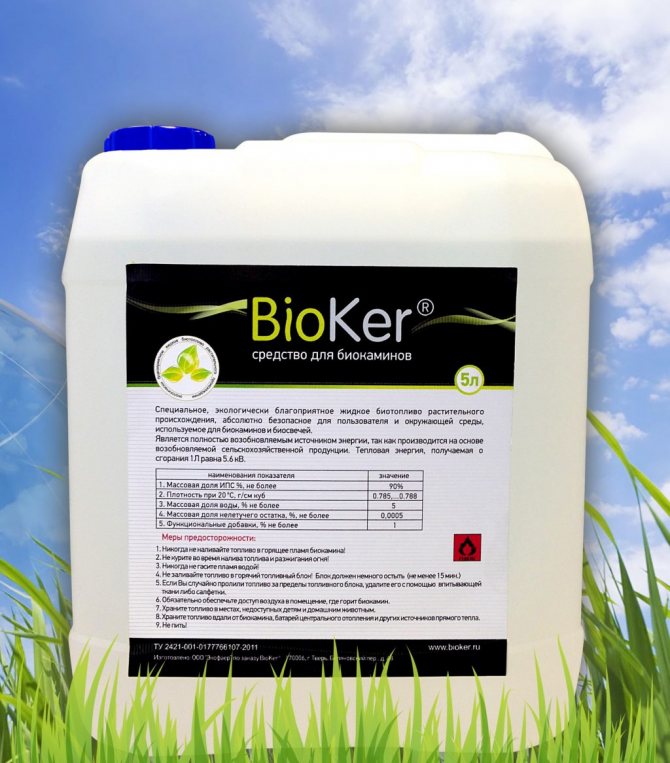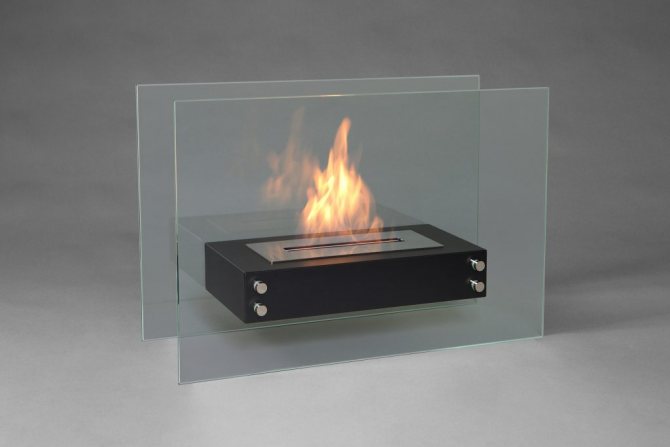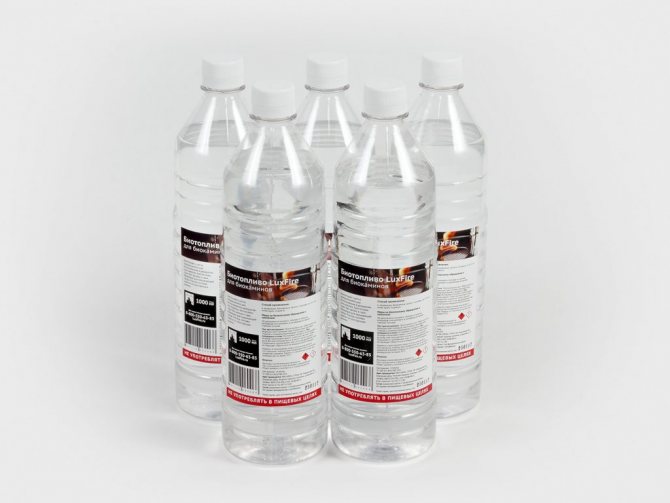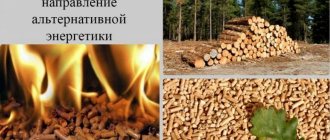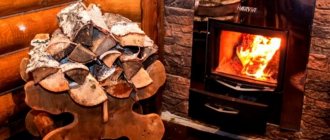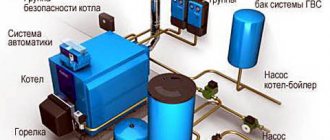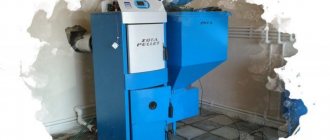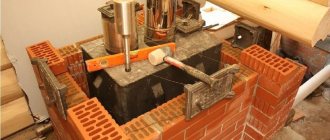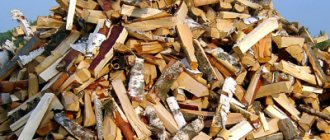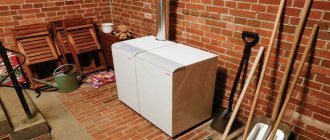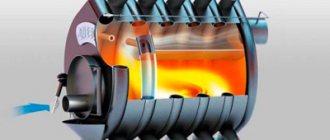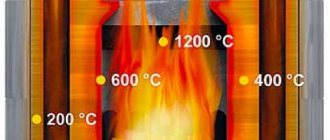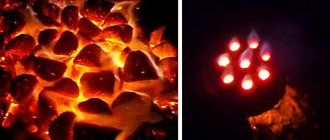When choosing a stove or fireplace, you need to build on not only the design of the heat source, but also the type of fuel. Solid fuel for different types of furnaces is usually used when heating a relatively small area. There are several types of energy sources and a lot of subspecies. Consider the features, advantages and disadvantages of the main options.
Figure 1. As fuel - the usual firewood
Heating with classics - wood
Firewood is a traditional option that literally everyone has come across. The classic logs are gradually being replaced by the modern alternative. But the drovish do not intend to completely give up their positions - they still have many advantages over new products.
Advantages of firewood:
- characteristics that are familiar to everyone - you know what to expect from wood blanks;
- aesthetic component; in fireplaces, firewood is used not only for practical purposes - the characteristic crackle in the hearth is still important for many consumers; soundtrack - the result of the effect of high temperature on the moisture remaining in the logs; modern solutions do not indulge in such aesthetics;
- relatively constant parameters; firewood can become damp and moldy, but they do not tend to crumble even after many years of storage;
- wood ash hardly smells.
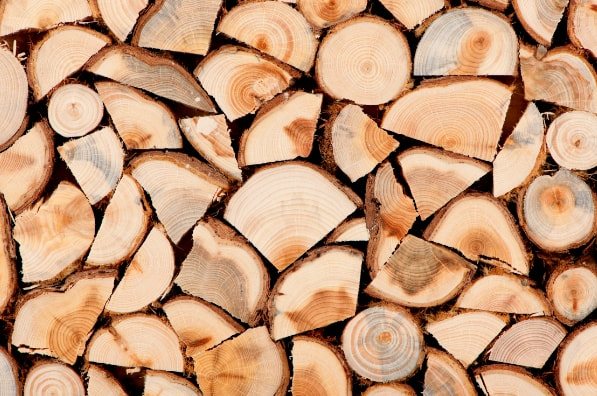
Figure 2. Firewood in the firebox
Disadvantages of firewood:
- the need for a dry storage place - logs do not tolerate high levels of moisture;
- different shapes and sizes (even if they are close in this regard) do not contribute to the convenience of storage;
- shorter combustion time than wood alternatives;
- less heat transfer;
- different intensity of combustion; usually the logs flare up for a certain time, followed by a culminating heat emission and attenuation;
- a large amount of ash - at least 15%;
- smoke;
- potential threat to health; firewood is safe, but damp logs can contain mold and mildew, and when burned, they can emit toxic smoke.
Firewood can be chopped and sawn. But the nature of the wood, on which its calorific value depends, is much more important. The approximate indicators of various tree species are in the table.
| Breed | Calorific potential, kW / h / kg |
| Larch | 4,3 |
| Spruce | 4,3 |
| Pine | 4,3 |
| Oak | 4,2 |
| Beech | 4,2 |
| Hornbeam | 4,2 |
| Ash | 4,2 |
| Birch | 4,2 |
Main properties and features
In the process of biofuel production, ethanol is denatured, making it neutral and safe for the human body, animals and other organisms. It decomposes easily during combustion, producing carbon monoxide, some steam and, of course, heat.
At the same time, the outlines of the fire are quite colorful, the tongues of flame are even, bright, saturated with color. The color of the flame, of course, is slightly different from the usual one, it is not so orange, since burning ethanol gives off carbon dioxide and water. To get a more natural fire, natural, environmentally friendly additives are added to the liquid fuel for fireplaces that color the fire in the desired orange color.
During combustion, environmentally friendly biofuel on bioethanol does not emit smoke or soot, the process is odorless and does not annoy us with any unpleasant aroma. It is for this reason that a fireplace with biofuel does not need a chimney and an exhaust hood.
Better yet, the heat generated by the combustion is not lost, but completely enters the room. Thus, the efficiency of such an installation reaches 95-100%. At the same time, by the type of flame, ecofuel for fireplaces is not much different from ordinary firewood, which allows you to contemplate a real fire.Fireplace gel, created on the basis of ethanol with the addition of sea salt, allows you to create a complete illusion of burning real firewood, since in addition to a similar fire, a characteristic sound design will appear in the form of crackling.
Good to know: Corner biofireplace, its advantages and use in the interior
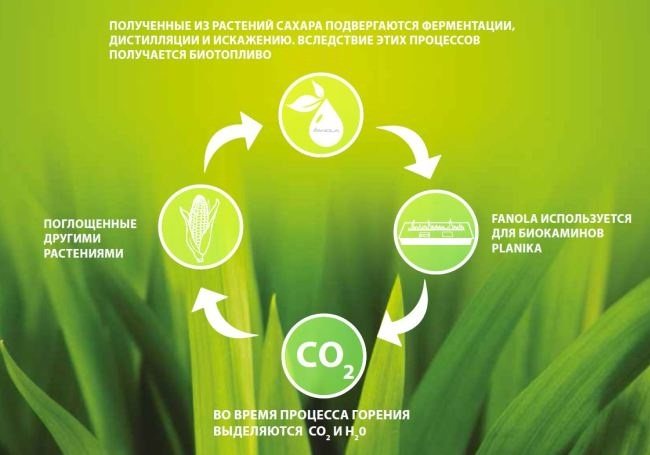

A biofuel fireplace in the process of its work, as we have already said, practically does not emit soot and soot. Experts compare its emissions into the atmosphere of a room with the combustion of one ordinary candle. At the same time, the liquid for the biofireplace does not emit carbon monoxide during combustion, which in large volumes can be dangerous.
Bioethanol used for fireplaces can also be poured into a regular kerosene lamp. In this case, during combustion, soot and odor will not be released, as during the combustion of kerosene, and the device will perform its initial functionality perfectly, illuminating the room.
Briquettes (euro wood)
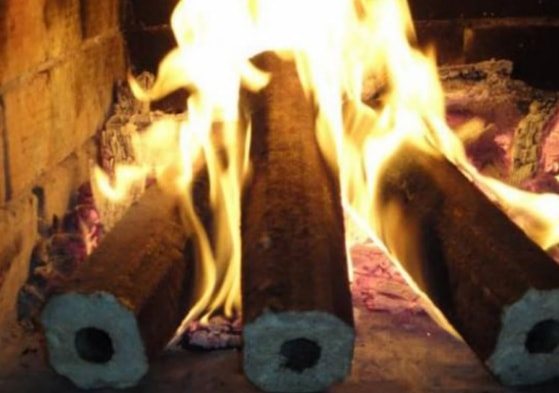

Figure 3. Euro wood in the oven
Briquettes are furnace fuel formed by pressing wood waste. During production, shavings, wood dust, chips, etc. are used. Due to the vegetable binder - lignin - Eurowood under normal conditions keep its shape reliably and do not crumble.
There are 3 types of Euro briquettes.
Ruf
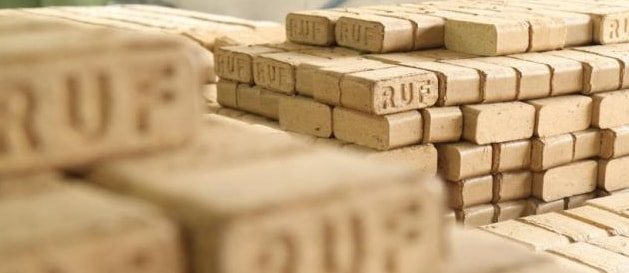

Figure 4. Eurobriquettes Roof
This is the most popular option that Europeans have been using for several years. After the work of the press, cute practical bricks remain. They bear little resemblance to firewood, but are characterized by an optimal ratio of quality and cost.
Pini kay
This look is in many ways similar to Roof, but briquette firing has been added to the production cycle. This allows you to increase the operational life and resistance of eurodrops to environmental aggression. Due to firing, a protective shell is formed on the outside of the products.
Nestro
Combined view. Unlike the first two, it has a shape similar to ordinary logs. There is a through hole inside the elements. No external firing.
Pros of briquettes:
- long burning time - up to 4 times longer than that of the traditional version; the advantage is due to the higher density of eurodrops;
- high heat transfer - approximately twice as high as that of logs;
- the same intensity of combustion; unlike firewood, pressed blocks burn evenly; moreover, even coals are capable of giving off the same amount of heat as a “fresh” briquette;
- almost complete wastelessness - after the combustion of the blocks, 1-3% of ash remains;
- the usefulness of ash; the previous plus can be considered a disadvantage, since waste serves as a very good fertilizer, in which there is a lot of potassium;
- environmental friendliness; briquettes do not contain any harmful substances; moreover, eurowood almost does not smoke, and the smoke that is there does not smell;
- saving;
- ease of storage and operation; the blocks are easy to store, they require less than firewood, there is no garbage left after them - secondary, but also important advantages.
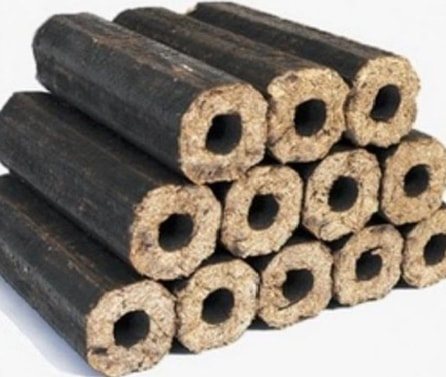

Figure 5. Euro wood with a hole
Cons of eurodrops:
- with a higher heat transfer, heat blocks give less than the "classic"; this means that they are not suitable as fuel for a sauna stove;
- under unimportant storage conditions, they can crumble; the reason is excellent moisture resistance; but in this case dignity becomes a disadvantage;
- variable characteristics depending on manufacturers; you need to try various options to understand your needs and preferences; briquettes differ somewhat in density and strength;
- the remains of the blocks have a not very pleasant smell;
- exceptional practicality - to the detriment of the aesthetic component.
Pyrolysis ovens
The classic structure of a pyrolysis oven is as follows. There is a common building. It has a built-in firebox with a burner for laying firewood. The firebox is designed so that it is possible to provide very small air supply (sealed, with a tight door and a well-functioning damper, equipped with a supply and exhaust fan). Firewood is laid in it, ignited with a burner or manually. After they flare up a little, the furnace is limited in the access of oxygen.
The firewood is charred, the resulting gas (half nitrogen and half a mixture of hydrogen, carbon monoxide, methane and carbon dioxide) from the bottom up through a separate air duct enters the second combustion chamber, where it mixes with air (secondary air inflow) in the required proportion and burns giving off heat. The second combustion chamber is structurally can be combined with the duct itself, or with the beginning of the chimney. It can be serviced by the same supply and exhaust fan, a separate fan can be mounted, or it can work only with the help of one sealed dampers on natural draft (with a well-thought-out chimney system).
If solid residues from the combustion of firewood are needed - provided
device for their extraction... In handicraft or industrial ovens, its role is usually played by a rotary "retort».
A retort is usually a round part of the body, into which firewood is laid, and then coke and coal are extracted from below.
Pyrolysis furnace differs from conventional furnaces in that, in fact, the fuel in it burns not right away, but in two stages, decomposing at the same time into solid residues and gas.
The solid residues are then also burned, the heat from them is also used to maintain a constant desired temperature in the primary furnace. In practice, firewood is burned completely, leaving only very little ash - this is another feature of pyrolysis ovens. Typically, such furnaces and boilers require ash removal every few days, or even once a week.
Pellets
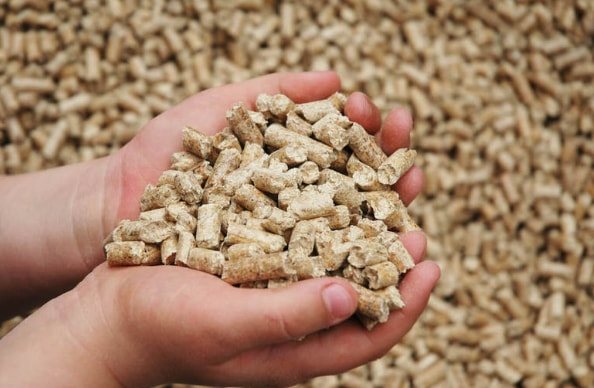

Figure 6. Pressed pellets for stoves
Pellets are small fuel pellets that are also produced by pressing waste from the woodworking industry and other types of economic activities. First, the source code is turned into wood dust, then thoroughly dried and granulated in special forms. Pellets are mainly used in furnaces that are designed for this particular type of fuel.
Depending on the raw material, pellets are divided into the following types:
- wood - from woodworking waste;
- straw;
- granules made from sunflower husks;
- peat.
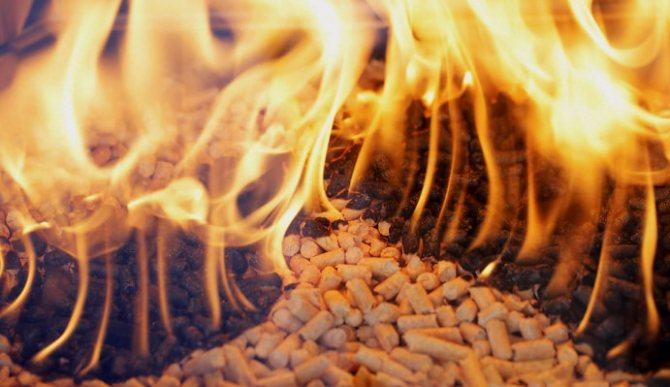

Figure 7. Burning pellets
The advantages of fuel pellets are similar to those of Euro briquettes. But pellets also have an original plus - their small dimensions allow them to be used in boilers with autoloading fuel.
The downside is that in most cases, pellets are only suitable for equipment that was originally designed for pellets. Although the use of pressed miniblocks is also possible in conventional ovens. But this requires a certain modernization of the units.
Biofuels
Conventionally, all produced biofuel for fireplaces can be divided into three groups:
- Bioethanol, denatured alcohol with some additives for realistic fire.
- Biodiesel based on vegetable oils.
- Biogas fuel produced from human waste and is considered an analogue of natural gas. It is mainly used for industrial purposes.
Biofuels are produced all over the world: in Europe, America, Asia and even Africa. Currently, Brazil is the main supplier of such products. Let's look at the fuel for a bio fireplace in more detail:
- Bioethanol, which looks like a colorless, odorless liquid, is created on the basis of alcohol. Alcohol for creating fuel is obtained from carbohydrates that are found in sugar, which is the key to the naturalness of the product. Sugar is extracted from reeds, potatoes, beets, and corn. Ethanol can be produced from wood raw materials in which cellulose is present.
- Biodiesel fuel, like bioethanol, is a safe and clean product; when it gets into water, it does not harm other organisms and the environment. This fuel is created from vegetable and animal fats, which can be obtained from coconut, soy, palm oils. Almost every liquid fuel fireplace in Europe uses biodiesel.
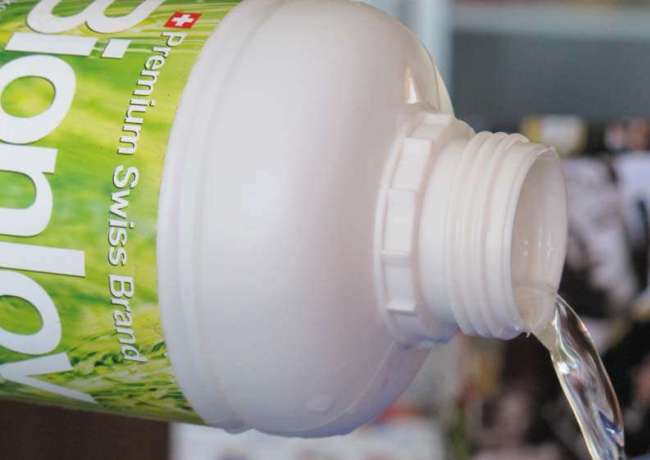

Biofuels made in Switzerland
When choosing a biofuel for use in a fireplace, pay attention to the certification documentation, and then to the level of thermal performance of the fuel, a description of the color of the flame, its sharpness and sound. After all, you have chosen a biofireplace for yourself in order to be able to contemplate a real fire at home, which is safe for you and the environment.
Good to know: How the burner for a biofireplace is arranged, drawings, do-it-yourself manufacturing
Homemade smokeless stove with your own hands
Able and talented specialists can make a pyrolysis stove with their own hands. However, in practice, this requires a lot of knowledge, skill and experience. In addition, daredevils who ventured into such an invention should know that in practice there are several pitfalls, about which many home-made devices have already been broken.
To complete the work, you need the following inventory:
- Welding machine;
- Competently designed drawing;
- Work experience directly in the furnace business.
However, even the presence of all this will not give a full guarantee of success in the implementation of the plan. Good, high-quality materials are also required for work, and their cost is now quite high. This mainly concerns the metal part, where good alloy steel must be used. In addition to everything, this unit also has an electronic system, without which the process of controlling the device is impossible. And without it, the operation of the device will not make sense. Therefore, before deciding to make a pyrolysis oven on your own, you should carefully consider all the nuances. It is realistic to build a working model of such a furnace, only its efficiency will be much lower than that of a high-quality industrial design, and your device will not pay off with fuel costs. In addition, if you cannot correctly configure the electronic part of the boiler, then you will have to constantly be near the boiler and monitor it. Many of the illiterately executed pyrolysis ovens have turned into another type of potbelly stove.
Water cut
Watering the fuel removes heat not only and not so much for the evaporation of water. At high temperatures in the presence of a catalyst - carbon - even more energy is spent on the chemical reduction of water and the combination of the released oxygen with atmospheric nitrogen. The water content of the fuel in percent by weight is denoted as W.
The ability of the fuel to absorb moisture, firstly, reduces its heat of combustion. For firewood - twice or more with an increase in humidity from 20% to 50%. Watered fuel oil can also be explosive. And barely wet brown coal ignites spontaneously, so it is not transported from the mining sites, thermal power plants on brown coal are built near mining pits.
A furnace operating on watered liquid fuel must be equipped with a special burner and a fuel preparation system. Solid fuel - a complex smoke path in which the reduced components and oxidized nitrogen do not cool down before decaying to the original ones and giving back heat.
The better to heat the fireplace
How to heat the fireplace in the house so that it is practical and aesthetically pleasing? The choice of fuel depends on the height of the flame, burning time, heat transfer and, oddly enough, the amount of soot and the type of firebox over time.
Therefore, we will consider the most common types of fuel for stoves and fireplaces in Belarus from all sides:
- firewood
- coal
- gas
- fuel briquettes
- wood pellets
- biofuel
Firewood and coal - good old classics, which is better left in your memories? Life is becoming more expensive and today it is important to think not only about aesthetics, but also about heat indicators and the duration of fuel burning in the fireplace. And firewood is far from the best option for fuel for a stove and fireplace. Technologies do not stand still, and today zealous owners choose long-burning euro wood for the furnace and fireplace. Simply put, compressed wood fuel: briquettes and pellets (pellets).
Furnace furnace with coal
Today coal is a rather rare type of fuel for heating a private house. It differs from other types of fireplace fuel in that the maximum heat transfer does not occur during combustion. but during decay. But in order for your fireplace to serve you as long as possible, it is important to know how to properly heat the fireplace with coal.
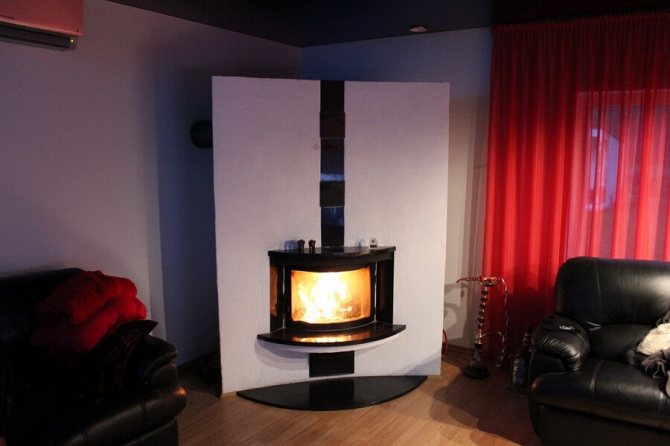

To do this, you must comply with 4 conditions:
- Timely clean the fireplace from ash.
- The combustion hole must be a cover.
- The blower door must be kept open until the fire ignites.
- It is possible to heat the fireplace with coal only if there is a grate in the stove. And since burning coal requires a lot of air, the height of the grate is important. To exclude steel burning out, it may be necessary to replace steel grates with cast iron ones.
- Both hard coal and brown coal are suitable for the fireplace insert. We recommend choosing a type of coal with a combustion temperature of up to 1500 degrees.
Purchase of dark heating oil
The Internet and advertising sites are full of offers for the sale of dark heating oil. However, if you go deeper, then buying dark heating oil in Moscow or the Moscow region of really acceptable quality becomes a difficult task. After all, most of the advertisements that say - sell dark heating oil cheap, in fact, do not correspond to reality. Often such ads are simply an advertising lure and upon the fact of your call, they turn out to be a waste of time. Many offers, which may seem profitable at first glance, turn out to be blatant lies and a trick of resellers.
In order to buy dark heating oil inexpensively and of truly decent quality, you need to work only with real sellers and owners of production facilities. In addition, a self-respecting organization for the manufacture and sale of liquid household heating oil will carefully monitor its reputation and will always be ready to provide samples for testing free of charge.
Heat of combustion and cost
The formal content of this paragraph does not require special explanations: kilocalories or joules. It can only be recalled that 1 kcal = 4.3 kJ. That is, if the heat of combustion is 10,000 kcal / kg, then in joules it will be 43,000 kJ / kg or 43 MJ / kg for solid fuel. For gaseous - kilocalories or kilo / mega joules per cubic meter. For liquid, reference books are given either per kilogram or per liter / cubic meter.
The heat of combustion of commonly used fuels ranges from 1,800 kcal / kg (waste wood: alder, willow, rotten raw brushwood) to almost 11,000 kcal / kg (polyethylene and other organic polymers), which in megajoules will be from 7.74 MJ / kg to 47.14 MJ / kg for polyethylene.
A nuance is already revealed here: you can completely burn everything, but the price of a kilogram is different! Therefore, we do this:
- We make a heat engineering calculation of the heating capacity of the room.
- We give it a 10-20% margin for hot water supply.
- We give to the received another 50% margin for abnormal cold.
- The obtained value is DIVIDED by the efficiency of the selected furnace.
- Based on the obtained required heat power of the furnace and the specific heating value of the fuel, we determine its mass / volumetric consumption.
- By multiplying the consumption by the cost, we get the unit cost of heating.
- We repeat the procedure for different stoves and fuels until we reach the minimum price.
Note: heating devices with an efficiency less than the threshold 70% can be ignored.Even if we personally have a purple ecology on the yellow side, there will be additional taxes and fines somewhere else. Required.

